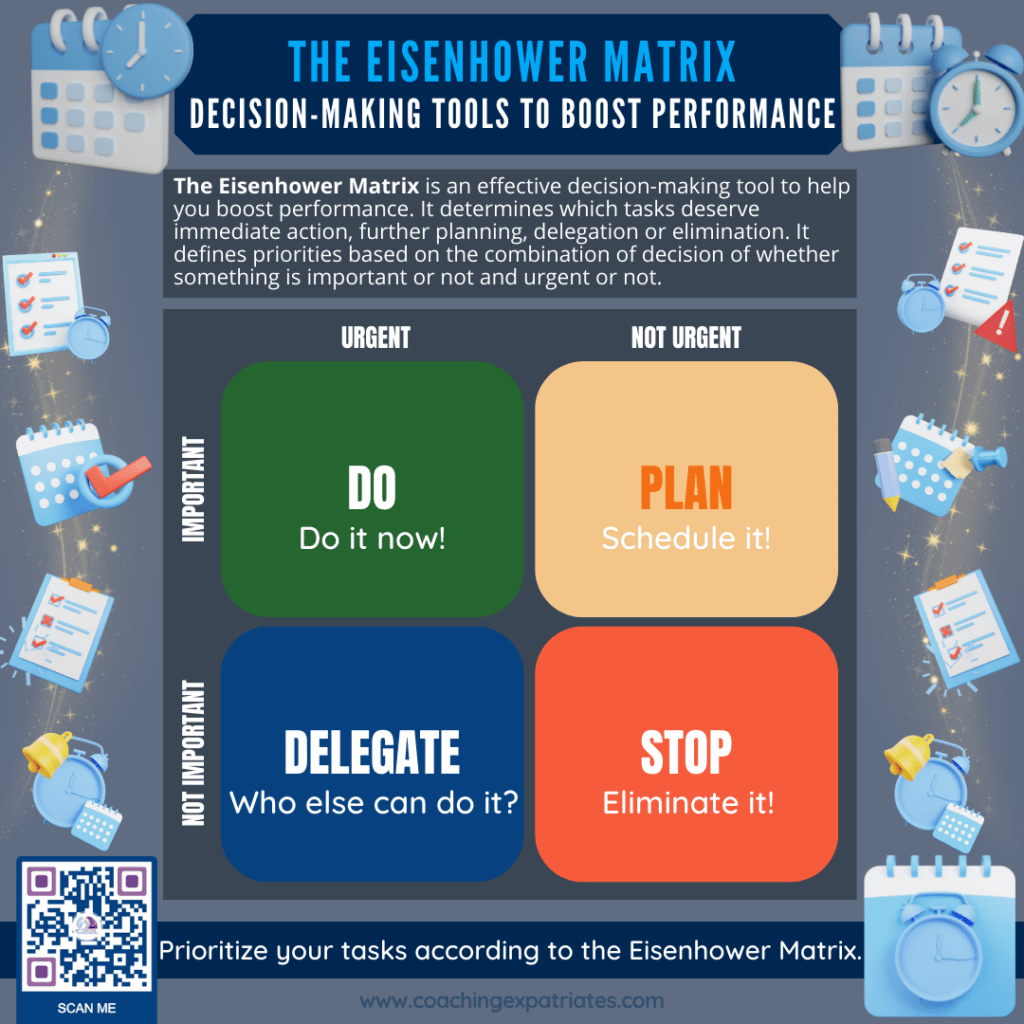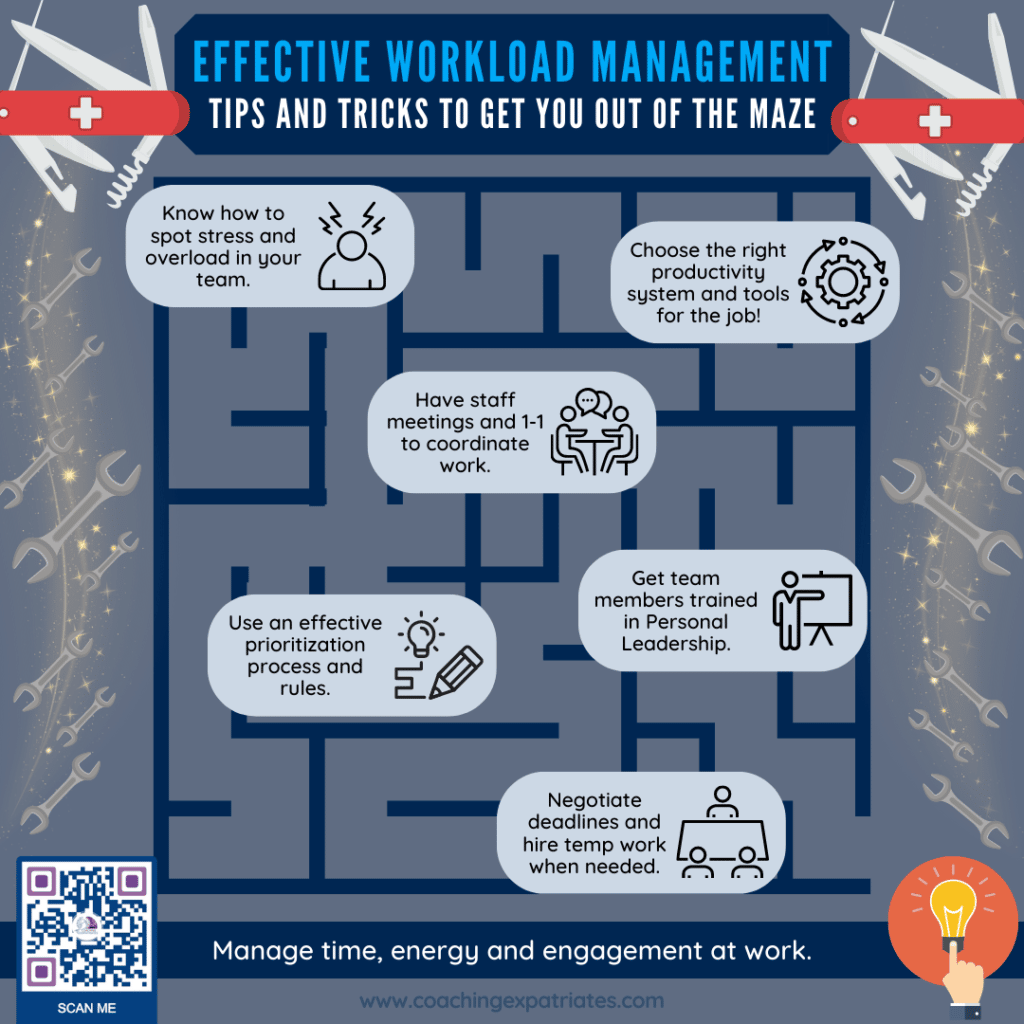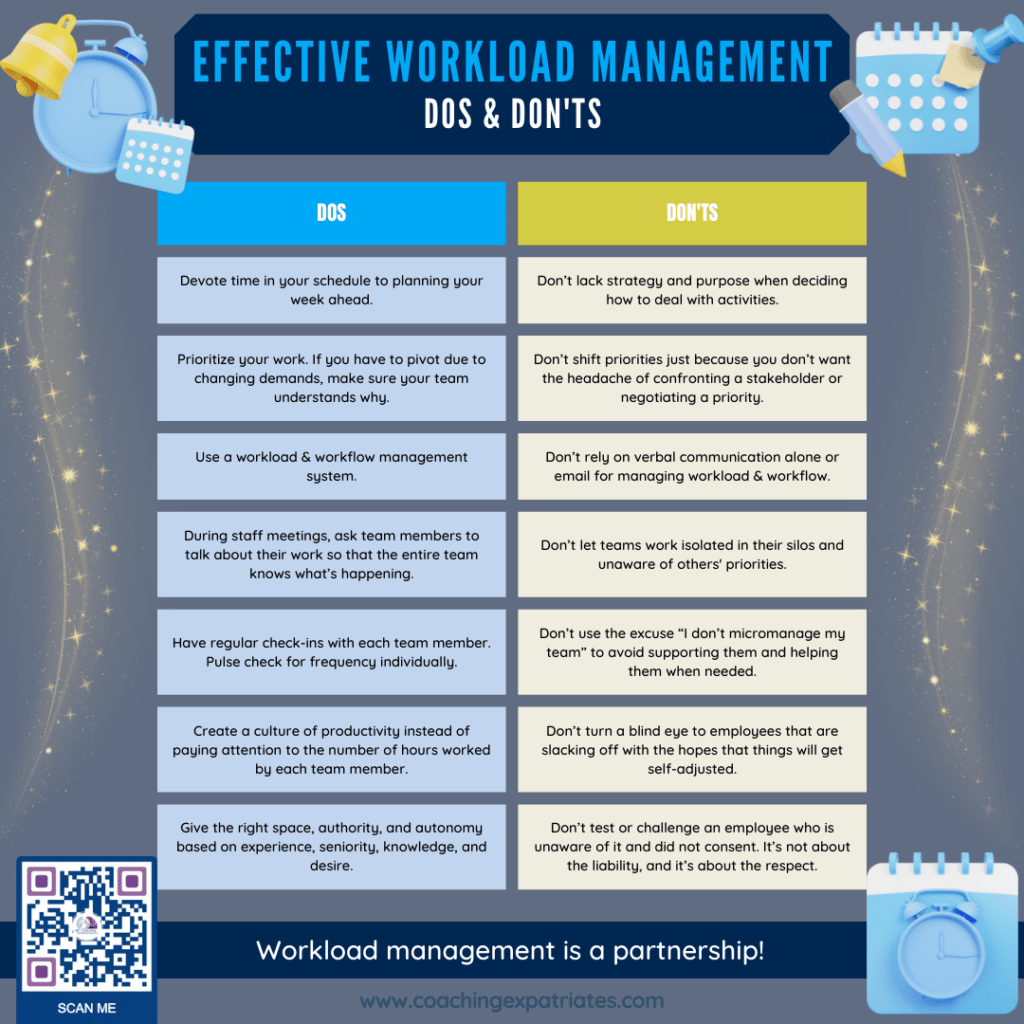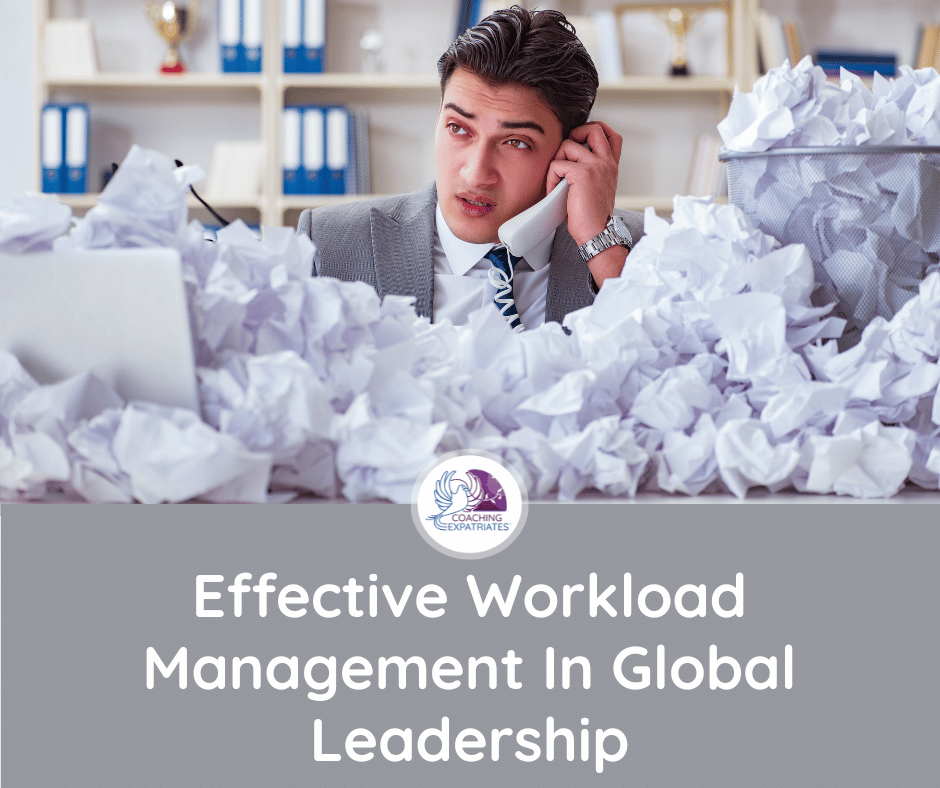Intending to help you become a unique and successful global leader, we recently discussed the 6 main global leadership pitfalls and their 31 traps that fall within these pitfalls. One of them is workload management, which can be something extremely challenging in global leadership due to differences in time zones, cultural communication styles, and remote work management.
Let’s discuss effective workload management, why it is so important in global leadership, how to organize and assign workload, and how to manage it effectively. Then, let’s also discuss some dos and don’ts.
What Is Effective Workload Management?
Workload management is often misunderstood in the corporate world. It does not mean assigning more or less work to people or teams. Rather, it means assigning work in a way that the job gets done efficiently and with the least amount of stress possible.
Effective workload management, therefore, is always a multi-step process that efficiently plans, schedules, distributes, and reviews work across teams in a way that allows them to do their best work while tracking the results.
4 key elements make part of effective workload management:
1) Utilizing resources effectively – human, intellectual, material, and technological resources.
2) Managing time and energy – it’s a misconception that managing time is enough. It’s also important to manage people’s energy and engagement.
3) Optimizing project schedules – to keep them on track and on budget.
4) Expectation Management – the better you manage people’s expectations, the smoother all the work will flow, with reduced stress and miscommunication.
As a leader managing team’s workloads, these 4 elements are essential and must be dealt with together for optimal performance.
Why Is Effective Workload Management Important?
Did you know that there is a unique relationship between intellectual demands, stress, and job satisfaction? Our job satisfaction rises when our intellectual demands feel good but decreases when the demands are too high and we get too stressed. And it has been shown that employees who stay stressed due to job demands for too long, end up leaving the company.
On top of that, if an entire team’s workload is too high and they’re over their capacity, it’s quite hard for them to do their best work, reflecting poor results. In global environments, this can be even worse: you cannot be at all places at all times, especially when you have team members all over the world! If you don’t manage your team’s workloads, their work environment will deteriorate quickly without you knowing it. They will become stressed, and you’ll have a hot mess to solve when it’s already too late.
You probably felt this yourself already, but let’s just spell it out here: if someone is constantly feeling under pressure and tied to unrealistic deadlines or workloads, this can quickly add to stress levels. According to Asana, 82% of employees feel less engaged at work when they are stressed.
In fact, there are 6 main reasons why you should learn about effective workload management to avoid lower engagement:
✅ To retain your best global talents
✅ To ensure work satisfaction is high amongst your team members
✅ To improve overall productivity rates
✅ To allow a positive work environment
✅ To support overall mental health and avoid stress, burnout, job-related errors, incidents, or injuries for all your team members
✅ To produce better results and higher company bottom lines
What Is The Best Way To Organize Your Workload As A Global Leader?
Here, I want to share a process you can go through to organize your ideas and what you must do. Later on, we will discuss how to manage the workload for an entire team.
For now, consider these steps for yourself:
- Begin With A Brain Dump – write down everything you have to do and the main stakeholders for each item you list.
- Keep Your Responsibilities In One Place – I like to say “Having your control tower” The more you keep your stuff in separate places, the worse you’ll manage what you have to do. Who doesn’t relate to sticky notes all over the place, phone notifications, calendar reminders, and even fridge reminders? Well, that’s not a best practice! Put everything in one same place. I call this my “Task Backlog list.”
- Make Your Task Backlog List Is Actionable – instead of putting in your list”Jack’s report,” put in your list what this means in terms of action: “A) Pull data to create a report for Jack, B) Create a report for Jack and C) Send Jack an email with the report.” This way, when you decide to actually work on “Jack’s report,” you know exactly what to do and how long it might take.
- Organize Your Task Backlog List By Categories – labeling or assigning categories will facilitate the prioritizing process.
- Prioritize Your Task Backlog List – not all tasks are the same. Some of them are more important, some less. Others are important but not urgent, and others are super urgent but not important. You can use the Eisenhower Matrix or define your own prioritization system to assign the right priorities for your task effectively. If you don’t know how to do this, take our free online High-Performance Workshop.

- Work Your System – plan your week ahead and which tasks from the backlog list should be moved to your “To-do” list in that week. Be purposeful when planning.

- Assign Deadlines For Each Task In Your To-dos List – this is pretty straightforward. If someone did not assign a deadline for you yet, do it yourself and make sure to give it a deadline. Remember, deadlines must be reasonable and feasible. If someone gave you a task without a deadline, go back to them and negotiate a deadline, based on your priorities. This is an excellent way to manage expectations and raise your performance.
- Estimate & Quantify How Long A Task Will Take To Complete – this is essential for the next step, and it’s a super pro tip. Estimating the time things take will also help you manage your own expectations. Even if estimating is difficult, it’s better to “guestimate” and learn from this exercise, than lose the opportunity to do so. When you estimate something that you don’t know how long it takes, you pay more attention to the timing and effort you put into things and gain self-awareness. Next time you have to estimate time for a similar task, things will go much smoother.
- Add Time-Based Items To Your Calendar – I have a simple motto: “if it’s in my calendar, I get it done.” Use the time you estimated to complete a certain task to allot time to complete it during your week. For example, you will take 45 minutes to pull the data in Jack’s report, half an hour to put together the report, and another 15 minutes to send the email. Then you see you have a 2 hours free spot in your calendar on Friday morning, so you block time off for Jack’s report in your calendar during that free spot.
- Leave Space For The Unexpected – I call this “buffer time.” Oh! Also, don’t forget to leave some room for pauses and breaks! This is a super pro tip that most global leaders forget about!
- Delegate When Needed! – there is nothing wrong with delegating stuff when needed. Just make sure you are not delegating stuff when the circumstances actually are more appropriate to be hands-on, as a boss.
- Use A Top Notch Productivity App – For me, this app must be able to do workload manament, workflow management, and note-taking, all-in-one, at the least. You’ll notice that some items from your brain dump list won’t seem to fit on your task list or calendar. These items are most likely merely notes. Notes are reference material. They don’t require any action. Things like ideas, instructions, and lists fit under the “Notes” umbrella. Your app must be able to do all this for you and your entire team. If your teams estimate the time they will spend on their activities, and you don’t have the capability to see that, this is not the right app. The same goes for time effectively spent. You must be able to see how much your team has been working to evaluate their workloads and capabilities.
- Choose The Right Productivity Tools For You – Within a productivity app, everyone has their own preference for tools, but my recommendation is that the selected tool has the capability to put labels or categories, priority levels, status in the process, deadlines, time trackers, time estimates, team member allocations, and a space for extra notes, instructions and ideas.
- Have Staff Meetings With Your Team Members To Coordinate Work. – you will notice that teams in the storming and norming phases of team performance will need more staff meetings, while teams already performing well together will have less frequent meetings. Have pulse checks to define with your team about staff meeting frequency.
- Have 1-1 With Team Members – Besides the staff meeting, when you meet all team members at once, it’s important to have 1-1s. Have more frequent 1-1s with less experienced team members while more spaced 1-1s with those who are more seasoned. Some tips to focus on while dealing with individual members:
- Know how to spot stress and overload in your team members. Some of them will not tell you they are struggling, fearing you will look down on them. If they are struggling, you should find ways to help them without hurting their pride
- Make sure they are working on the right things. Based on your prioritization system, help your employees focus their time and attention on the right tasks, people, and projects. If priorities change, let them know as soon as they did and why. You will be perceived as confusing and unreliable if you don’t let them know why things are pivoting.
- Take notes about your conversation with your employees. Even if you have a good memory, you will notice that 2 things will happen by taking notes. Besides documenting relevant facts and decisions, you will also lead by example and invite your employees also to take notes, which will help them be more spot on in their performance.
- Communicate concisely but effectively. Use the 5WH framework to manage your team member’s expectations.
- Pay attention to headcount. Sometimes your employees will tell you they need extra help and ask you about headcount or temporary hiring to help them. Don’t dismiss this conversation. This is the first sign they are feeling overwhelmed.
- Negotiate Reasonable Deadlines For Tasks, Projects, And Transitions. As mentioned, even if a task does not have a defined tentative deadline, it’s always best to create one. If the task or demand in question comes from someone else, go back to them and define an agreed deadline. This will help you manage everyone’s expectations (including yours), and it will help you get a better perspective in terms of the task’s priority in the face of everything else you have to do.
- Recruit Temporary Assistance When Needed. Start working on recruiting temporary assistance for the high seasons at least 3 months before. Coordinate with your teams what’s needed and by when. As a learning opportunity for your team, you can rotate amongst the team members who will be the hiring manager.

Step By Step Process To Creating An Effective Workload Management Process For Your Team
Now that you learned the main things to have and coordinate for your own workload as the team leader, let’s talk about how to coordinate your team’s workload.
Before we start talking about this, it’s critical that you get all your team members trained in Personal Leadership. Personal leadership is the type of leadership that leads self. There are 5 main elements to it: how to manage your personal stress, how to be more productive and manage your time, how to coordinate your values and purpose with your work, how to manage your mental health, and how to manage your self-discipline and self-care.
I personally believe that this type of training should be given as part of a regular onboarding for every employee. We, as global leaders, should not put everything on the team leader’s shoulders. All individual contributors must be well versed in all 5 elements of personal leadership to keep up with the good work.
A team leader with employees who know personal leadership will have better chances of managing workload than a team leader whose employees are completely oblivious about it.
Personal leadership is one of the 4 pillars of the 4 Success Pillars In Global leadership, a methodology to help leading members in multinational and multicultural organizations thrive as a leader and as a professional.
With that being said, the process below will allow leaders globally to manage workload more effectively.
Team Workload Management Basics:
STEP 1: Always be on top of your team’s capacity
To know your team’s capacity, everyone must use the same workload management system. If you work for traditional global corporations that are not project management or consulting based, that company will probably not offer you any sophisticated tool to manage workload. You’ll rely on verbal communication. Or, conversely, you can talk to IT and implement your own tool for your department. Today there are many online options like Monday.com, ClickUp, Workfront, Asana, and many others. Choose one that makes sense for your team or department, and implement it.
STEP 2: Based on the team’s capacity, plan out projects, tasks and transitions collaboratively
Nowadays, it’s almost impossible just to do repetitive and seasonal work. Very likely, an internal or even external client will require something new from you and your team. Before simply assigning it to your team as a done deal, review your team’s capacity, then negotiate deadlines and service level agreements. Plan in a collaborative way whenever possible. Once you decide which tasks and projects to accept, make sure to place them in the timeline to see what the team’s capacity will look like.
STEP 3: Allocate tasks to team members
Once you know what your stakeholder is demanding and you have already negotiated a timeline with them, it’s time to allocate tasks among your team members. Don’t fall into the leadership trap of allocating the tougher jobs to your high achievers only. Give opportunities to all team members. Make sure you distribute well the work, efforts, and opportunities.
STEP 4: Use a workflow management tool
Most top workload management tools will also provide you with workflow management capabilities. Workload management tools often offer time estimates, time trackers, and time allocations so you can see how much time each team member will use in each task or group of tasks. And that’s why you can see their capacity and workload. In turn, workflow management is a system that shows you where in the process each task is. Did they start it already? Is it done? Is it in the middle of the process, or maybe did it go for review? Each department and team has its own workflow, depending on the process they have to complete. A workflow for a group of auditors will look like differently from a workflow for a a group of journalists.
STEP 5: Monitor schedules & projects constantly while communicating with the entire team and each individual
As part of your personal workload management, we recommended above that you keep both staff meetings and 1-1s with your team members. Leverage these conversations and what you learn from them while building trust and monitoring schedules and projects. If you see an individual in your team is having a hard time, talk to them and see if they are in need of help. While you are at it, don’t forget to take notes! They are extremely useful during effective workload management. You can’t remember every single detail from every member! Read our incredible guide on how to take notes to raise performance efficiently.
Consider redistributing work and efforts if needed or if someone in the team is struggling. Also, make sure you make a thermometer check during these 1-1 conversations to assess job satisfaction and learning. Don’t wait until the performance review to manage your employee’s expectations.

Although not formally part of an effective workload management ideology, I want to spell it out here, because most leaders forget about this altogether. When you see a bigger task or project was completed by a team member or by an entire team, take some time to celebrate and reward your team. This is often overlooked, but it’s a pro tip to ensure job satisfaction that we discussed in the beginning.
Another important aspect is constant and timely constructive feedback. Giving and receiving feedback is part of a healthy process of expectations management. The better you do it, the more constructive and efficient your relationships with people around you will be. And as we said in a previous post, your working relations are the best assets you’ll collect during your working life!
Effective Workload Management: Dos And Don’ts
Here are some tips that are not exactly part of the effective workload management process but that come in handy when managing it efficiently:
Dos:
- Devote time in your schedule to planning your week.
- Prioritize your work. If you have to pivot due to changing demands, make sure your team understands why.
- Use a workload & workflow management system.
- During your staff meetings, have each team member talk about what they are working on so that the entire team knows the gist of what’s happening.
- Have regular check-ins with each team member. Pulse check for frequency individually. Some people will need more frequent 1-1s, and others, less so.
- Create a culture of productivity instead of paying attention to the number of hours worked by each team member.
- Give the right space, authority, and autonomy based on experience, seniority, knowledge, and desire.
Don'ts:
- Don’t lack strategy and purpose when delegating activities.
- Don’t shift priorities just because you don’t want the headache of confronting a stakeholder or negotiating a priority.
- Don’t rely on verbal communication or email for managing workload & workflow.
- Don’t let teams work isolated in their silos.
- Don’t use the excuse “I don’t micromanage my team” to avoid supporting them and helping them when needed.
- Don’t turn a blind eye to employees that are slacking off with the hopes that things will get self-adjusted.
- Don’t test or challenge an employee who is unaware of it and did not consent. It’s not about the liability, and it’s about the respect. Old school leaders used to test employees a lot without their knowledge. Helping them “grow a thick skin” without their consent is not acceptable anymore.

Final Thoughts
Effective workload management is not rocket science, so long as you have the right training and tools to manage it. On top of that, the entire team must be on board with this and be diligent in using their knowledge and tools for the right purpose.
I’ve seen teams with the “Ferrari” of the workload management tools but used them only once a week instead of daily. Outdated or inconsistent information makes it difficult for any manager to manage things appropriately.
If you experience these issues with your team, it’s time to talk to HR and define a team-building event to map and close any gaps you have. If that’s not enough for specific team members, a more punctual approach might be needed for that person. Don’t take your time to deal with trouble-makers. They can disrupt the entire team.
Whatever the case, my takeaway here is that workload management is not something you do alone. It’s a partnership both with your team members as well as other key functions in the organization. For it to be effective, the partnership must go well in all fronts.
You can hire me as your executive and development coach if you want to go the extra mile when managing your teams and their workloads. Have a free strategy call with me. We will go over your specific needs and define the best course of action together to help you become an admirable leader who helps each of your team members achieve their goals while feeling fulfilled and successful.
If you are interested in developing specific global leadership skills to improve your performance as a leader and manager, check out our online Global Executive Leadership Program. We go over all 4 success pillars of Global Leadership during 9 online modules specially meant for global leadership.
If you enjoyed this post, consider subscribing to our newsletter using the form below. We focus on providing good content to global leaders and executives who want to make impactful business decisions and be more inclusive and influential. We know your inbox is sacred, so we email just once per week, and we never sell your information. Trust is the basis of Global Leadership, and we fully honor it.







